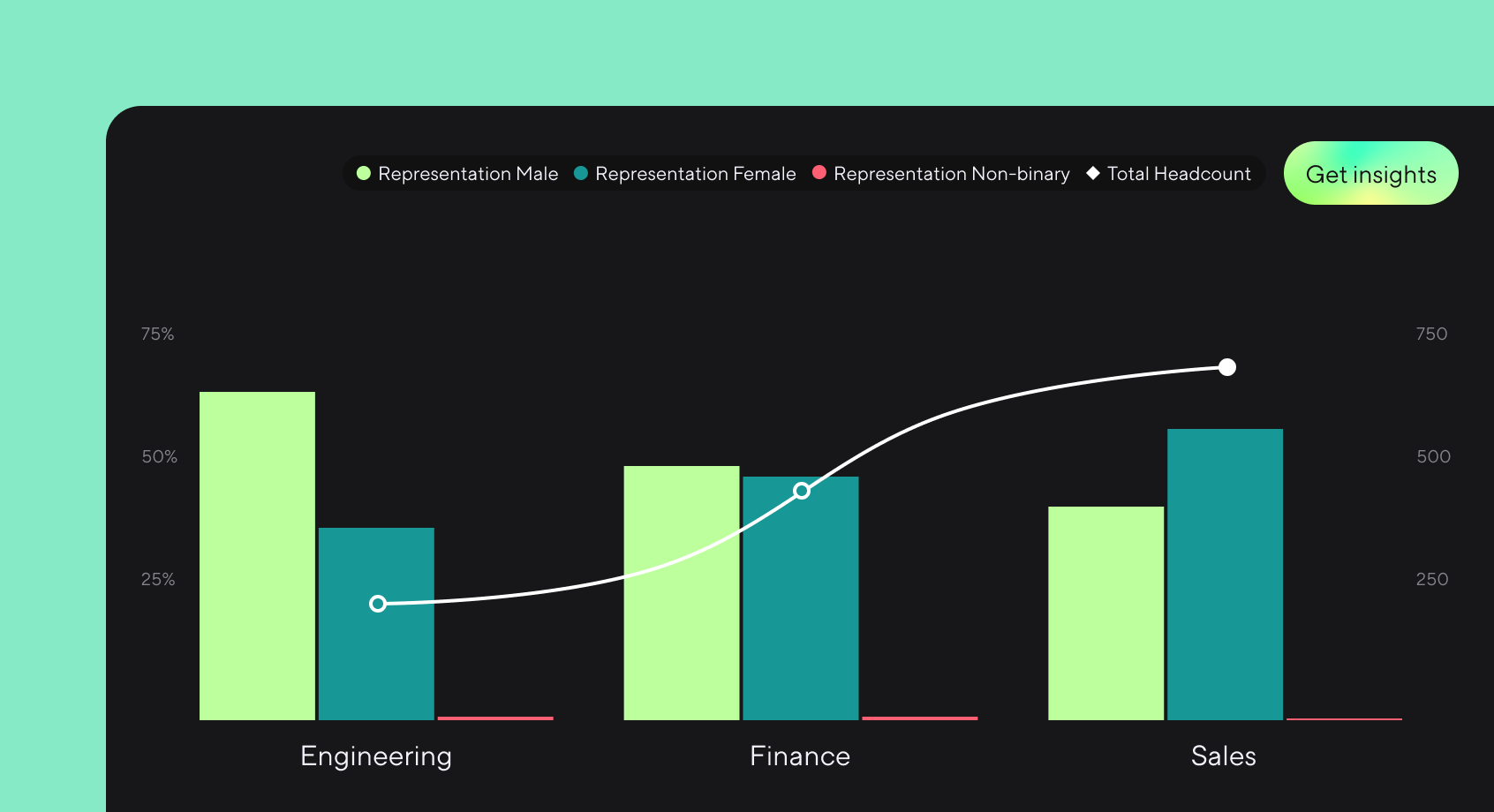In the era of pay transparency, data matters more than ever

Camille Hogg, PhD – Dec 14th, 2022
Pay transparency is more than just posting a salary range on new job openings. As organizations grapple with new pay transparency laws, data is an essential tool for driving more equitable compensation practices.

Pay transparency is often thought to start and end with salary.
Consider the recent pay transparency laws in California and New York, which are primarily focused on mandating that organizations include salary benchmarks in job advertisements, promotions, and transfer opportunities.
These numbers will be of great use to job-seekers, employees, and employers alike. But they only tell part of the story when it comes to pay. And this can lead to confusion.
The reality is that pay transparency is not well understood today—by employers or employees. Almost 80% of employees want some form of pay transparency—but according to a 2022 study, most employees don’t actually have a consistent understanding of what that means.
Without direction or context, pay transparency can backfire. It’s easy to post a salary range—but it’s hard to explain how you got there. And it’s even harder to unwind processes and identify the threads that lead to pay inequity.
But when you have the right data to frame your decision-making, it means you’re able to explain what people get paid and why. The key to getting this right is in how you integrate and measure pay transparency alongside your DEI strategy.
What pay transparency is, what it isn’t, and why it matters.
Pay transparency refers to the practice of openly sharing compensation processes. It’s less about showing a number, and more about showing employees they’re being paid fairly through equitable processes, actions, and culture.
At a basic level, pay transparency focuses on:
- How organizations pay their employees
- How they make pay decisions
- What their compensation philosophy is
- How they communicate compensation to employees
Pay transparency means showing employees they're being paid fairly through equitable processes, actions, and culture.
Pay transparency is a spectrum, rather than an action—and it looks different for every organization. Approaches vary wildly, from sharing internal salary bands, to publishing salaries in the public sphere. Neither is right or wrong. The best approach for your organization ultimately depends on what feels fair according to your own culture, values, and compensation philosophy.
When done well, pay transparency is powerful for talent attraction and retention. A UK-based survey found that 36% of candidates would self-select out of the interview process if the organization wasn’t upfront on salary. Meanwhile, a 2022 compensation report by Visier found that almost 70% of employees would leave their organization for greater transparency elsewhere.
Organizational psychology backs this up. When employees feel fairly rewarded for their contributions at work, they’re more likely to have high levels of job satisfaction, which has a trickle-down impact on productivity and performance.
Being open on how people get paid creates an environment where job satisfaction and mutual trust thrive. But implemented in isolation, pay transparency won’t get organizations to more equitable compensation outcomes, or support your DEI strategy long-term.
Pay transparency supports fairness. Fairness supports DEI.
Employee compensation is far more complex than the number people get paid. It’s intrinsically linked to employee performance and career progression. And because we know that these processes are prone to unconscious bias, and that some people are more likely to be under-rewarded, under-promoted, and under-represented than others, we know that compensation is a DEI issue.
That makes pay transparency a DEI issue, too.
Organizations with a strong commitment to diversity, equity, and inclusion experience higher levels of employee commitment, job satisfaction, and belonging. And when we view pay transparency through a DEI lens, we can see the impact of this relationship more clearly:
- It helps organizations close the gender pay gap: A ten-year study found that pay transparency motivates employers to rally their efforts on closing the gender pay gap. Women are 5% more likely to get hired at a role above median wage when pay transparency is implemented.
- It can help tackle systemic racism. Pay discrimination in the hiring process has historically led to inequitable outcomes. When Black candidates negotiate for higher salaries, they’re seen as pushier than White peers.
- It promotes fairness: According to a 2022 report, under 30% of employees feel they’re paid fairly. A 2021 study found that if employees can discuss pay with their peers and understand the compensation process, they develop a greater perception of fairness and trust towards their employer.
Pay transparency creates fairness, fairness builds trust, and trust fosters belonging. But fairer pay is only possible when organizations understand where all of their compensation processes are unintentionally causing pay gaps and inequities.
Scaling transparent pay processes and policies, with data.
According to a recent report, around 30% of organizations aren't clear on whether their pay gaps are gender- or race-related. This uncertainty, coupled with a lack of oversight into how compensation and DEI intersect, often means that organizations unintentionally foster unfairness across interrelated pay processes, despite correcting for pay gaps with salary adjustments.
But when organizations take a data-driven approach to their wider compensation processes, they gain greater clarity on how each of them impacts pay equity. This enables them to create a structured compensation philosophy and policy that scales fairness for everyone.
Aligning pay transparency with your DEI strategy depends on using data to create and maintain interrelated processes: role design and levels, promotions, salary benchmarking, and pay gaps.
When organizations take a data-driven approach to understanding their compensation processes, they learn how each of those practices impacts pay equity.
Define roles and job levels with fairness in mind
When exact role requirements or processes around progression are shrouded in secrecy, employees have no context of exactly what’s expected of them, and promotion pathways can seem ambiguous.
And the larger you get, the more this lack of structure harms transparency—because it magnifies the discrepancies between job titles, responsibilities, and compensation.
Creating structure around roles and job levels fosters greater pay transparency by minimizing compensation and promotion bias, clearly communicating role expectations, and providing a methodology for fairness.
Create equitable promotion processes
Lack of growth and career progression are among the key reasons why employees leave. Underrepresented employees are disproportionately passed over more often for promotions—especially when we’re talking about upward mobility to manager or senior roles.
Together with job leveling, creating repeatable frameworks around employee progression means employees know the exact skills and capabilities they need to demonstrate to move to the next opportunity.
Taking a data-driven approach here can further this impact. Analyzing employee progression data by dimensions of diversity, as well as factors including tenure, office location, business unit, or seniority, helps you identify exactly where your processes are prone to bias.
Use DEI analytics to benchmark salary ranges
Salary benchmarking is a helpful tool for understanding how other organizations’ compensation compare to yours based on size, industry, or location. While benchmarking might help you stay competitive in your market, it won’t help promote salary transparency by itself—because it only gives you the broader picture of how people get paid.
This misses the finer details of employee compensation, and that’s where pay inequity tends to hide.
Ultimately, each organization needs to define their compensation policy based on what feels fair at a cultural level.
Benchmarking your salary data using DEI analytics offers greater clarity on how different employee populations are compensated relative to other organizations. It gives you the salary range—but it also tells you who’s likely to be paid below this benchmark, how similar organizations to yours look in terms of gender, race, or ethnicity composition, and what you can do to redress the balance in your own talent strategy.
But remember that paying your employees the same as other companies won’t help you embed greater pay transparency or improve pay equity unless you’re able to explain why external numbers have influenced your decision-making at an internal level.
Ultimately, external salary benchmarking should be used as a guide—but each organization needs to define their compensation policy based on what feels fair at a cultural level.
Identify pay gaps across your organization—continuously
When pay gaps pop up, it’s a sign that your compensation model isn’t working as well as it could. Proactively working to solve pay gaps increases pay equity, fostering greater transparency, trust, and a sense of fairness.
This is most effective when coupled with regular pay audits.
Most organizations run pay audits once a year—which makes it much harder to spot when pay gaps occur, much less offer solutions that establish equity for the current composition of their workforce. But tracking and analyzing pay by employee lifecycle factors and dimensions of diversity helps you identify how well your compensation model is working—in real time.
This helps you understand not only how different employee populations are paid relative to others, and which pay gaps are most likely to occur internally—but how and where they occur across different points in the employee journey, so you can adjust processes to minimize bias.
Transparent processes, fairer outcomes.
Pay equity doesn’t work without pay transparency. But pay transparency can’t truly embed as part of your culture and DEI strategy without a data-driven approach.
Creating a data-driven process that analyzes not only how people get paid and promoted—but who—is essential to fostering transparency long-term.

When organizations connect pay transparency efforts to data, they’re able to identify when bias is creeping into promotion processes, or understand how discrepancies in job titles and levels mean some employees are disproportionately under-rewarded. Most importantly, they’re able to do something about it—so that pay transparency becomes a way of operating that paves the way to greater equity.
Dandi’s DEI analytics helps organizations create greater transparency around their compensation philosophy and policies, with real-time reporting on salary benchmarking, pay audits, performance management, and pay gaps. Dandi offers insights in minutes, but gives organizations the insights needed for long-term impact on DEI.
More from the blog
Announcing more powerful Dandi data visualizations
Team Dandi - Oct 23rd, 2024
The New Maturity Model for HR Data
Catherine Tansey - Sep 5th, 2024
Buyer’s Guide: AI for HR Data
Catherine Tansey - Jul 24th, 2024
Powerful people insights, 3X faster
Team Dandi - Jun 18th, 2024
Dandi Insights: In-Person vs. Remote
Catherine Tansey - Jun 10th, 2024
Introducing Dandi AI for HR Data
Team Dandi - May 22nd, 2024
5 essential talent and development dashboards
Catherine Tansey - May 1st, 2024
The people data compliance checklist
Catherine Tansey - Apr 17th, 2024
5 essential EX dashboards
Catherine Tansey - Apr 10th, 2024
Proven strategies for boosting engagement in self-ID campaigns
Catherine Tansey - Mar 27th, 2024









